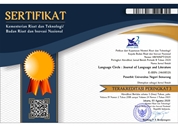IMPROVING COHESION OF THE STUDENTS’ SENTENCES THROUGH THE APPLICATION OF COHESION THEORY IN THE SENTENCE-BASED WRITING CLASS
(1) Semarang State University
Abstract
This study was aimed at 1). describing what kinds of cohesive device mostly occured in the students’ sentences, 2). describing how to apply cohesion theory in the sentence-based writing class, and 3). finding out whether the use of cohesion theory gives its positive significance to cohesion of the students’ sentences. This is an action research study employing two cycles. The subject of the study was 24 students of group 2, in a class of SBW, and the object of the study was students’ sentences created by the students in the teaching and learning process. The result of the study shows that cohesive devices mostly employed by the students are references followed by lexical, conjunction and substitution. Moreover, the students never used ellipsis in the students’ sentences. In the teaching and learning process, cohesion theory was given to the students in two cycles. The first cycle focused on introducing the cohesion theory and its kinds of cohesive devices. Then, in the next cycle the students learned about Halliday and Hasan Taxonomy. Based on the result of the study, teaching SBW using cohesion theory gives its positive significance by varied cohesive device used by the students. It can be seen from the analysis of the students’ sentences from pre-test, paragraph 1, paragraph 2, paragraph 3 and post-test. The students also give positive responses upon its teaching and learning process using cohesion theory based on the pre and post-test questionnaire data. It is hoped that the result of the study gives positive contribution to the students in preparing them to write in bigger contexts such as paragraph-based writing, genre-based writng and academic writing in the next coming semesters.
Keywords
Full Text:
PDFReferences
Baker, Mona. 1992. In Other Words: a course book on translation. London: Routledge
Bamberg, B. (1983). What makes a text coherent? College Composition and Communication, 34(4), 417-429.
Coulthard, 1994. Advanced in Written Text Analysis. London: Routledge
Eggins, Suzanne. 1994. An Introduction to Systemic Functional Linguistic. London: Pinter Publsiher
Halliday, M.A.K. & Hasan, Ruqaiya. 1976. Cohesion in English. New York: Longman
Nunan, David. 1993. Discourse Analysis. London: Penguin Group
Oshima, Alice & Hogue, Ann. 1999. Writing Academic English. New York: Pearson
Paltridge, Brian. 2001. Genre and the Language Learning Classroom. Michigan: The University of Michigan Press.
Rankema, Jan. 1993. Discourse Studies: An Introductory Textbook. Amsterdam: John Benjamins Publishing Company.
Wang, Lixia. 2007. Theme and Rheme in the Thematic Organization of Text: Implications for Teaching Academic Writing. Asian EFL Journal, Vol.9, No 1.
Wells, G. 1987. Apprenticeship in Literacy. In Interchange 18, 1/2: 109-123.
Witte, Stephen P. & Faigley, Lester. 1981. Coherence, Cohesion and Writing Quality. College Composition and Communication, 32, 189-204.
Refbacks
- There are currently no refbacks.

This work is licensed under a Creative Commons Attribution 4.0 International License

